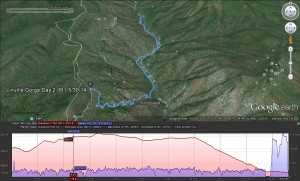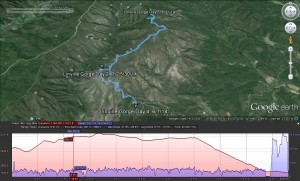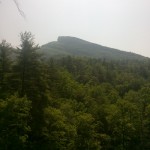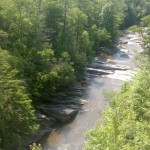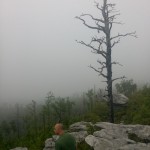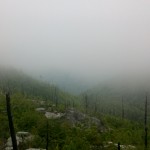Join us for 4 days of hammock camping, hiking and backpacking in North Carolina’s Linville Gorge wilderness area.
Located in the Pisgah National Forest, Linville Gorge – or simply “The Gorge” as local hikers prefer to call it – is a 12 mile long gorge carved into the surrounding southern Appalachian mountains by the Linville River. The distance from upper ridge to the river below is roughly 1,400′, which coupled with the network of minimally maintained wilderness trails and unofficial trails, can make for quite a rugged experience. This is not the rolling mountain experience offered up by the neighboring Smoky Mountains, lumbering just 75 miles to the west. The Gorge has a reputation for being a bit of a beast. And yet for some reason I couldn’t help but notice a permanent trace of laziness in the air.
Typically, I quite enjoy the hustle of a good long distance hike. The more miles, the more exciting the trip, but Linville Gorge quickly had a different affect on me. I spent most of my time on the trail daydreaming about the next time I could be swinging in my hammock. Which was perfect because Mike and I had 4 days off and nothing to do but just that.
Speaking of days off, it should be pointed out that the Forest Service has enacted a consecutive stay limit of 2 days, 3 nights for camping within the Linville Gorge wilderness area. Fortunately, the surrounding Pisgah National Forest does not have such restrictions. With a little planning, you can easily spend a night just outside the limits of the wilderness area and you’re good to go. There are decent opportunities for this strategy along the western side of the Gorge, where the Mountains to Sea Trail follows along the boundary line. From May 1st through October 31st there is also a permit required for back-country camping on weekends and holidays. Thankfully, it’s free and simple – I called a few weeks beforehand and they actually faxed me our pass within a half hour or so.
If you decide to plan a trip of your own, I highly recommend heading over to the forums on Linvillegorge.net. The Gorge Rats have a wealth of knowledge and are very friendly and helpful to those of us noobs looking to rummage through The Gorge. There’s also treasure trove of goodies for your GPS including potential camp sites, water sources, official and unofficial trails, points of interest, etc.
Full GPS data for this trip, recorded with my Garmin Oregon 650, is available for download on the Trip Data page.
Parking Location:
Conley Cove Trail Head N35 53.414 W81 54.380
Link to Nebo Water Gauge:
http://waterdata.usgs.gov/usa/
There are currently no bridges across the river, so trust me, you want to keep an eye on this. Readings of 100 cfs or less seem to be ideal. 200 cfs will create approximately waist deep conditions.
Hammocks Used
Mike:
Hennessy Expedition Asym with standard tarp
Eno Atlas Straps with Black Diamond Neutrino
Carabiners
Myself:
Hennessy Expedition Asym with Hennessy Deluxe Hex Tarp (12’x12′)
Liberty Mountain Aluminum Guyline Adjusters for tarp pullouts
Kammok Python Straps with Black Diamond Neutrino Carabiners
Want more gear list info? Check out my previous video: Ultralight Backpacking Gear List
List of Trails Used, Day 1:
Conley Cove Trail
Linville Gorge Trail (Follows river along bottom of gorge)
Set up camp near the banks of the Linville River
Mileage for the Day: 10.9 miles
Elevation Gain: 1,627′
Elevation Loss: 2,185′
List of Trails Used, Day 2, Part 1:
Return to Car via Conley Cove and LGT
Drive to second location.
Mileage for the Day Part 1: 3.9 miles
Elevation Gain: 1,204′
Elevation Loss: 535′
Second Parking Location:
Wolfpit Trailhead N 35 49.449 W 81 53.365
List of Trails Used, Day 2, Part 2:
Wolfpit Trail
Mountain to Sea Trail (MST)
Set up Camp along cliff near Shortoff Mountain
Mileage for the Day Part 2: 2.3 miles
Elevation Gain: 1,109′
Elevation Loss: 75′
List of Trails Used, Day 3:
Continue on Mountain to Sea Trail (MST)
Set up camp along the MST, outside of wilderness area.
Mileage for the Day: 6.3 miles
Elevation Gain: 840′
Elevation Loss: 1,112′
List of Trails Used, Day 4:
Reverse course on the Mountain to Sea Trail (MST)
Shortcut via Jeep Trail (circumvents Day 2 Campsite)
Wolfpit Trail
Return to Wolfpit Parking area and car
Mileage for the Day: 5.8 miles
Elevation Gain: 892′
Elevation Loss: 1,795′
Total Mileage for Trip: 29.2 miles
Total Elevation Gain for Trip: 5,672′
Total Elevation Loss for Trip: 5,702′
- Looking up towards Hawksbill Mountain from the Linville River.
- Looking down upon the Linville River, just north of the former Spence Bridge.
- A lone tree along the Mountain to Sea Trail
- Looking into the Gorge towards Cambric Trail

